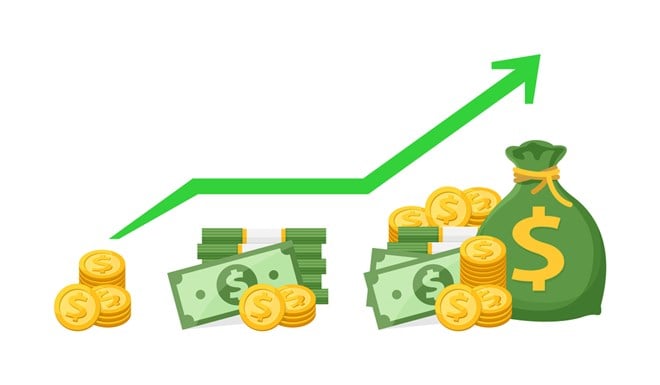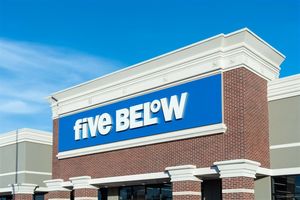
Can you get the best of both worlds? Growth stocks and dividend stocks, combined? The answer is yes. However, you may want to keep your efforts separate as well. If you are looking to create wealth with a longer time horizon, growth stocks may allow you to enjoy lengthier returns. If you prefer a steady cash flow, dividend stocks might make the most sense for you.
When a company finally starts actively making consistent profits, it may return excess cash to shareholders through dividend payments.
In this piece, we'll walk through the definition of growth and dividend stocks, learn how to identify the best growth and dividend stocks to invest in and find out how to choose the right combo for your portfolio.
So, what are growth stocks and dividend stocks, exactly? Let's kick off our investigation of growth and dividend stocks by finding out.
What Are Growth Stocks?
A growth stock is a publicly traded share in a company that grows at a rate higher than the market average. A growth stock may have also shown above-average earnings over the course of time. Here are two well-known examples of growth stocks: Alphabet Inc. (NASDAQ: GOOG, GOOGL) and Meta Platforms Inc. (NASDAQ: FB).
What Are Dividend Stocks?
Dividend stocks are companies that regularly share profits with shareholders through dividends. These companies are typically profitable and usually pay dividends on an ongoing basis.
Companies usually pay dividends on a quarterly basis, although some pay annually and a few pay monthly. Companies that pay dividends are usually more stable, such as in this list of Dividend Aristocrats, which have regularly raised their dividends over the past 25 years:
- AT&T (NYSE: T)
- International Business Machines (NYSE: IBM)
- Leggett & Platt (NYSE: LEG)
- Franklin Resources (NYSE: BEN)
- Walgreens Boots Alliance (NASDAQ: WBA)
- Amcor (NYSE: AMCR)
- Realty Income Co. (NYSE: O)
- 3M (NYSE: MMM)
- People's United Financial (NASDAQ: PBCT)
- V.F. Co. (NYSE: VFC)
- AbbVie (NYSE: ABBV)
- Chevron (NYSE: CVX)
- Federal Realty Investment Trust (NYSE: FRT)
- T. Rowe Price Group (NASDAQ: TROW)
- Consolidated Edison (NYSE: ED)
- Kimberly-Clark (NYSE: KMB)
- Cardinal Health (NYSE: CAH)
- Clorox (NYSE: CLX)
- Genuine Parts (NYSE: GPC)
- Air Products and Chemicals (NYSE: APD)
- Coca-Cola (NYSE: KO)
- Aflac (NYSE: AFL)
- Essex Property Trust (NYSE: ESS)
- PepsiCo (NYSE: PEP)
- Illinois Tool Works (NYSE: ITW)
- NextEra Energy (NYSE: NEE)
- Medtronic (NYSE: MDT)
- Colgate-Palmolive (NYSE: CL)
- Atmos Energy (NYSE: ATO)
- Johnson & Johnson (NYSE: JNJ)
- Procter & Gamble (NYSE: PG)
- Emerson Electric (NYSE: EMR)
- Stanley Black & Decker (NYSE: SWK)
- McDonald's (NYSE: MCD)
- Sysco (NYSE: SYY)
- General Dynamics (NYSE: GD)
- Caterpillar (NYSE: CAT)
- Cincinnati Financial (NASDAQ: CINF)
- Hormel Foods (NYSE: HRL)
- Automatic Data Processing (NASDAQ: ADP)
- PPG Industries (NYSE: PPG)
- A.O. Smith (NYSE: AOS)
- Archer-Daniels-Midland (NYSE: ADM)
- Pentair (NYSE: PNR)
- Lowe's Companies (NYSE: LOW)
- Chubb (NYSE: CB)
- Abbott Laboratories (NYSE: ABT)
- Linde (NYSE: LIN)
- Target (NYSE: TGT)
- McCormick & Company, Inc. (NYSE: MKC)
- Walmart (NYSE: WMT)
- Dover (NYSE: DOV)
- Becton, Dickinson and Co. (NYSE: BDX)
- W.W. Grainger (NYSE: GWW)
- Nucor (NYSE: NUE)
- Ecolab (NYSE: ECL)
- Expeditors International of Washington (NASDAQ: EXPD)
- Sherwin-Williams (NYSE: SHW)
- Cintas (NASDAQ: CTAS)
- Albemarle (NYSE: ALB)
- S&P Global (NYSE: SPGI)
- Roper Technologies (NYSE: ROP)
- West Pharmaceutical Services (NYSE: WST)
How to Identify Growth Stocks to Invest in
When you're interested in choosing the best growth stocks, there are a few steps you can take.
Step 1: Check out long-term trends.
How do you identify long-term market trends and the companies that can profit? Unfortunately, there's no guaranteed way to know what will happen in the stock market. Gradual changes or mountain-shaped spikes can come at the drop of a hat. One of the best ways to help guide your investment decisions involves checking out trends. Stock market indicators are created to track the performance of an index or market average of a stock.
Step 2: Check out companies that edge the competition.
Which businesses offer strong competitive advantages?
Investing success doesn't always focus just on company profits. Competitive advantages refer to the aspects of a business that allow the company to defend its profits from competitors. Companies with strong competitive advantages will have advantages. It's easy to identify loads of companies that have competitive advantages, including Amazon, Tesla, Starbucks, Coinbase and a long list of others.
Corporate advantages can include a wide variety of factors, including patents, technology and other factors. You can leverage these factors to choose which types of companies to invest in. Ultimately, do everything you can to determine how a company performs relative to its peers.
Step 3: Take a look at certain metrics.
Once you winnow your list to a handful of companies, look at various indicators, including debt load, which indicates how well a company takes care of its financials. Take a look at the debt-to-equity ratio, which measures a company's total debt relative to market value. Divide the total liabilities listed on the company balance sheet on its earnings statement by the total amount of shareholder equity — hopefully at 0.3 or less. A too-high level of debt could affect profits. You'll also want to peek at the price-to-earnings ratio (P/E ratio), which shows the price related to company earnings. Divide the company's share price by its annual earnings per share to learn a company's P/E ratio.
How to Identify Dividend Stocks to Invest in
Identifying dividend stocks looks similar to choosing growth stocks to purchase. However, you're looking specifically at dividends in this case.
Step 1: Compare dividend yields.
When sifting through all your dividend options, it's a good idea to compare dividend yields. You may initially want to achieve the highest dividends possible, but a too-high dividend may signal financial difficulties for a company. In general, you'll want to look for a dividend yield between 2% to 4%. Anything above 4% can be a great buy but anything sky-high can be risky. Consider a company's true financial health to decide whether a company can indeed continue its dividend payments. You can take a few steps to ensure that you find the right dividends for your needs.
How do you calculate dividend yield? Take the annual dividend per share divided by the stock's price per share. For example, if a company's annual dividend is $2 and the stock trades at $50, the dividend yield is 4% ($2/$50).
A too-high dividend yield can indicate an unsustainable payout, which might also drive down the share price of the stock in question.
Step 2: Look at payout ratios.
A stock payout ratio tells you how much of the company’s income goes toward dividends. The payout ratio can be calculated using the following formula:
Payout Ratio = Total Dividends / Net Income
A high payout ratio (one that hovers around 80%) can indicate that a company may be going into debt to offer dividends to shareholders.
Step 3: Take a look at other metrics.
You'll also want to take a look at the same types of metrics that we listed above for growth stocks, including the debt-to-equity ratio, the P/E ratio and more.
How to Invest in Growth and Dividend Stocks
How do you combine methods of investing in both growth and dividend stocks? Examine all metrics for both growth and dividend stocks, then choose the stocks that you want to buy.
Step 1: Diversify as you narrow your list.
Diversification means that you choose to invest in a wide variety of stocks. For example, if you invest in 10 stocks, three might be in industrials, two might be in consumer staples and the other two might be in a different sector, such as materials.
Step 2: Invest.
Once you've found a company that you believe fits your requirements, it's time to invest. If you already have a brokerage account, you're in good shape. If not, you can set up one fairly quickly. Once you set up your brokerage account, you're ready to buy. Choose the number of shares you want to purchase and choose your order type for investment:
- Market order: Here, you purchase or sell your stock at the best available price.
- Limit order: In this order type, you request to buy or sell at a specific price or better.
- Stop-loss order: With this order type, once a stock gets to a certain price, a market order shows up and the order is filled at that price.
- Stop-limit order: As soon as a share price meets the stop price, the trade goes into “limit order mode” and fills up to the specified price limits.
Finally, don't forget about your stocks as time goes on. Monitor your stocks long into the future to make sure they're still meeting your needs.
Consider Growth Stocks that Also Pay Dividends
Growth stocks that also pay dividends might be right up your alley. Consider investing in these five growth stocks that also offer dividends:
- The Goldman Sachs Group Inc. (NYSE: GS)
- Cigna Co. (NYSE: CI)
- Becton Dickinson and Co. (NYSE: BDX)
- FedEx Co. (NYSE: FDX)
- T. Rowe Price Group Inc. (NASDAQ: TROW)
Still not sure which direction to go? A financial advisor may be able to help you choose the right combination of dividend and growth stocks for your future goals.







